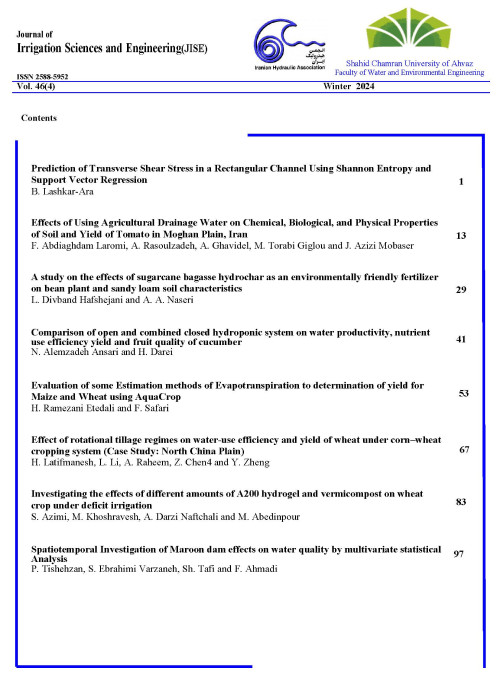Modeling for Estimation of the Field Capacity Moisture of Different Soils in Semi-arid Area
Author(s):
Abstract:
Modeling of water flow through vadose zone under unsaturated conditions necessitates the knowledge of soil hydraulic properties, which are water retention curve and water field capacity of soil. Indirect prediction of these characteristics based on readily available soil properties in the form of pedotransfer functions (PTFs) as a fast and low-cost solution has been widely practiced and very useful in irrigation and drainage. This study aimed to present the proper PTFs using mathematical modelling for estimating soil moisture at point of field capacity for Khuzestan province soils under laboratory and field conditions. The buried probes of the time domain reflectometry device (TDR) were inserted at various depths in order to monitor soil moisture conditions in both the physical model and experimental field under a surface-point source drip irrigation with discharge rates of 4 lph. Then, physical soil properties and soil water contents at their specific matric potentials were measured to calculate the hydraulic parameters of Van Genuchten-Mualem model with the RETC program. The results of this research to evaluate the performance of several well-known Point-PTFs showed that quasi-empirical models based on physical principles that have been tested in the field can be a good alternative to traditional methods for estimating water field capacity of soil. So that, the PTF of Twarakavi et al. could carefully predict that water field capacity of soil with indices of normalized root mean square error (3.1 percent) and standard error (0.5 percent) and more accurate than Rosetta artificial neural network approach or Dexter equation. Accordingly, another two PTFs were proposed to improve the accuracy of the water field capacity prediction in the form of regression equations on the basis of the parameters of Van Genuchten model and readily available soil properties for the semi-arid region of Khuzestan province. Results of obtained PTFs showed clearly negative effects of soil compaction and the amount of sand on the water field capacity of soil. On the contrary, the amount of clay and silt had positive and increasing effects on the water field capacity of soil, significantly.
Keywords:
Language:
Persian
Published:
Irrigation Sciences and Engineering, Volume:39 Issue: 4, 2017
Pages:
181 to 192
magiran.com/p1629761
دانلود و مطالعه متن این مقاله با یکی از روشهای زیر امکان پذیر است:
اشتراک شخصی
با عضویت و پرداخت آنلاین حق اشتراک یکساله به مبلغ 1,390,000ريال میتوانید 70 عنوان مطلب دانلود کنید!
اشتراک سازمانی
به کتابخانه دانشگاه یا محل کار خود پیشنهاد کنید تا اشتراک سازمانی این پایگاه را برای دسترسی نامحدود همه کاربران به متن مطالب تهیه نمایند!
توجه!
- حق عضویت دریافتی صرف حمایت از نشریات عضو و نگهداری، تکمیل و توسعه مگیران میشود.
- پرداخت حق اشتراک و دانلود مقالات اجازه بازنشر آن در سایر رسانههای چاپی و دیجیتال را به کاربر نمیدهد.
In order to view content subscription is required
Personal subscription
Subscribe magiran.com for 70 € euros via PayPal and download 70 articles during a year.
Organization subscription
Please contact us to subscribe your university or library for unlimited access!


